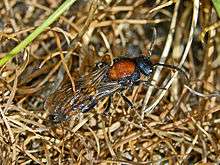Mutilla europaea
| Mutilla europaea | |
|---|---|
 | |
| Male of Mutilla europaea | |
| Scientific classification | |
| Kingdom: | Animalia |
| Phylum: | Arthropoda |
| Class: | Insecta |
| Order: | Hymenoptera |
| Suborder: | Apocrita |
| Superfamily: | Vespoidea |
| Family: | Mutillidae |
| Subfamily: | Mutillinae |
| Genus: | Mutilla |
| Species: | M. europaea |
| Binomial name | |
| Mutilla europaea Linnaeus, 1758 | |
| Synonyms | |
| |
Mutilla europaea is a species of parasitoid wasps belonging to the family Mutillidae.
Description
Mutilla europaea can reach a body length of 11–17 millimetres (0.43–0.67 in) in males, of 10–15 millimetres (0.39–0.59 in) in the females. These wasps are covered in dense velvet-like hair. Males have dark, transparent wings, while females are wingless and may frequently be confused with members of the true ant family (hence the common name of Velvet Ants). Adults display aposematic coloration, consisting of black overall coloring with an orange-red patch on the dorsal surface of the thorax. On the abdomen there are three whitish or yellowish hairy bands. The adults can be found from the end of May to end of August.
Mutilla europaea are mainly parasitoids of the resting stage of bumblebees (Bombus spp.), but occasionally visits honey bee (Apis mellifera) hives and Polistes wasps nests, ovipositing inside the cocoons. The larva of this wasp eats the immature bumblebee larva and nymphs and feed on the host honey and pollen stores. Then the larva of Mutilla spins a cocoon inside the cell of its host.
Distribution
This species is widespread in most of Europe, in the East Palearctic ecozone, in the Near East and in North Africa.
Habitat
This parasitic wasp is mainly montane and it is particularly widespread in the Alps, but can also be found in different habitats (woodland, grassland, etc.).
References
| Wikimedia Commons has media related to Mutilla europaea. |
- Biolib
- Fauna Europaea
- G R Else and J P Field Bees, Wasps & Ants Recording Society
- Alessia Uboni, M. Cristina Lorenzi Poor Odors, Strength, and Persistence Give Their Rewards to Mutilla europaea Visiting Dangerous Wasp Nests
External links